NPP and Carbon Emissions under Forest Fire Disturbance in Southwest and Northeast China from 2001 to 2020
Abstract
1. Introduction
2. Materials and Methods
2.1. The Study Area
2.2. Data and Methods
2.2.1. Forest Fire Data and Its Processing
2.2.2. NPP Data and Its Processing
2.2.3. Meteorological Data and Elevation Data
2.2.4. The Amount of Forest Burning Calculation
2.2.5. Calculation of Carbonaceous Gas Emissions from Forest Burning
2.2.6. The Spatial-Temporal Statistical Methods
3. Results
3.1. Spatiotemporal Distribution Characteristics of Forest Fires in Southwestern and Northeastern Regions of China
3.2. Estimation of Carbon-Containing Gas Emissions and Carbon Emissions from Forest Fires in Southwestern and Northeastern Regions of China
3.3. Spatiotemporal Distribution Characteristics of NPP in Southwestern and Northeastern Regions of China and the Relationship with Forest Fire Carbon Emissions
4. Discussion
4.1. The Establishment of the Relationship between Forest NPP and Forest Fire Carbon Emissions Involves Many Areas That Cannot Be Considered Individually
4.2. The Inventory of Forest Fire Combustion Emission Factors Is Mostly Derived from Previous Empirical Values, and the Results Are Subject to Some Errors
4.3. The Impacts of Forest Fire on Climate Change May Be Complex and Far-Reaching
5. Conclusions
Author Contributions
Funding
Data Availability Statement
Acknowledgments
Conflicts of Interest
References
- Lal, R. Forest soils and carbon sequestration. For. Ecol. Manag. 2005, 220, 242–258. [Google Scholar] [CrossRef]
- Fernández-Martínez, M.; Vicca, S.; Janssens, I.A.; Sardans, J.; Luyssaert, S.; Campioli, M.; Chapin, F.S.; Ciais, P.; Malhi, Y.; Obersteiner, M.; et al. Nutrient availability as the key regulator of global forest carbon balance. Nat. Clim. Chang. 2014, 4, 471–476. [Google Scholar] [CrossRef]
- Nemani, R.R.; Keeling, C.D.; Hashimoto, H.; Jolly, W.M.; Piper, S.C.; Tucker, C.J.; Myneni, R.B.; Running, S.W. Climate-driven increases in global terrestrial net primary production from 1982 to 1999. Science 2003, 300, 1560–1563. [Google Scholar] [CrossRef] [PubMed]
- Zhao, J.; Wang, J.M.; Meng, Y.F.; Du, Z.Q.; Ma, H.; Qiu, L.H.; Tian, Q.; Wang, L.; Xu, M.Y.; Zhao, H.F.; et al. Spatiotemporal patterns of fire-driven forest mortality in China. For. Ecol. Manag. 2023, 529, 120678. [Google Scholar] [CrossRef]
- Crutzen, P.J.; Heidt, L.E.; Krasnec, J.P.; Pollock, W.H.; Seiler, W. Biomass burning as a source of atmospheric gases CO, H2, N2O, NO, CH3CJ and COS. Nature 1979, 282, 253–256. [Google Scholar] [CrossRef]
- Seiler, W.; Crutzen, P.J. Estimates of gross and net fluxes of carbon between the biosphere and the atmosphere from biomass burning. Clim. Chang. 1980, 2, 207–247. [Google Scholar] [CrossRef]
- Hu, T.X.; Zhao, B.Q.; Li, F.; Dou, X.; Hu, H.Q.; Sun, L. Effects of fire on soil respiration and its components in a Dahurian larch (Larix gmelinii) forest in northeast China: Implications for forest ecosystem carbon cycling. Geoderma 2021, 402, 115273. [Google Scholar] [CrossRef]
- Zheng, B.; Ciais, P.; Chevallier, F.; Chuvieco, E.; Chen, Y.; Yang, H. Increasing forest fire emissions despite the decline in global burned area. Sci. Adv. 2021, 7, 39. [Google Scholar] [CrossRef]
- Chen, A.P.; Tang, R.Y.; Mao, J.F.; Yue, C.; Li, X.R.; Gao, M.D.; Shi, X.Y.; Jin, M.Z.; Ricciuto, D.; Rabin, S.; et al. Spatiotemporal dynamics of ecosystem fires and biomass burning-induced carbon emissions in China over the past two decades. Geogr. Sustain. 2020, 1, 47–58. [Google Scholar] [CrossRef]
- Bastit, F.; Brunette, M.; Montagné-Huck, C. Pests, wind and fire: A multi-hazard risk review for natural disturbances in forests. Ecol. Econ. 2023, 205, 107702. [Google Scholar] [CrossRef]
- Zheng, B.; Ciais, P.; Chevallier, F.; Yang, H.; Canadell, J.G.; Chen, Y.; van der Velde, I.R.; Aben, I.; Chuvieco, E.; Davis, S.J.; et al. Record-high CO2 emissions from boreal fires in 2021. Science 2023, 379, 912–917. [Google Scholar] [CrossRef] [PubMed]
- Korontzi, S.; Justice, C.O.; Scholes, R.J. Influence of timing and spatial extent of savanna fires in southern Africa on atmospheric emissions. J. Arid. Environ. 2003, 54, 395–404. [Google Scholar] [CrossRef]
- Sun, Y.P.; Zhang, Q.X.; Li, K.L.; Huo, Y.N.; Zhang, Y.M. Trace gas emissions from laboratory combustion of leaves typically consumed in forest fires in Southwest China. Sci. Total Environ. 2022, 846, 157282. [Google Scholar] [CrossRef]
- Romanov, A.A.; Tamarovskaya, A.N.; Gloor, E.; Brienen, R.; Gusev, B.A.; Leonenko, E.V.; Vasiliev, A.S.; Krikunov, E.E. Reassessment of carbon emissions from fires and a new estimate of net carbon uptake in Russian forests in 2001–2021. Sci. Total Environ. 2022, 846, 157322. [Google Scholar] [CrossRef] [PubMed]
- French, N.H.F.; Goovaerts, P.; Kasischke, E.S. Uncertainty in estimating carbon emissions from boreal forest fires. J. Geophys. Res. 2004, 109. [Google Scholar] [CrossRef]
- Song, R.; Wang, T.J.; Han, J.C.; Xu, B.Y.; Ma, D.Y.; Zhang, M.; Li, S.; Zhuang, B.L.; Li, M.M.; Xie, M. Spatial and temporal variation of air pollutant emissions from forest fires in China. Atmospheric. Environ. 2022, 281, 119156. [Google Scholar] [CrossRef]
- Shi, Y.S.; Zang, S.Y.; Matsunaga, T.; Yamaguchi, Y. A multi-year and high-resolution inventory of biomass burning emissions in tropical continents from 2001–2017 based on satellite observations. J. Clean. Prod. 2020, 270, 122511. [Google Scholar] [CrossRef]
- Michel, C.; Liousse, C.; Grégoire, J.M.; Tansey, K.; Carmichael, G.R.; Woo, J.H. Biomass burning emission inventory from burnt area data given by the SPOT-VEGETATION system in the frame of TRACE-P and ACE-Asia campaigns. J. Geophys. Res. 2005, 110, D09304. [Google Scholar] [CrossRef]
- Akagi, S.K.; Yokelson, R.J.; Wiedinmyer, C.; Alvarado, M.J.; Reid, J.S.; Karl, T.; Crounse, J.D.; Wennberg, P.O. Emission factors for open and domestic biomass burning for use in atmospheric models. Atmos. Chem. Phys. 2010, 11, 27523–27602. [Google Scholar] [CrossRef]
- Sannigrahi, S.; Pilla, F.; Basu, B.; Basu, A.S.; Sarkar, K.; Chakraborti, S.; Joshi, P.K.; Zhang, Q.; Wang, Y.; Bhatt, S.; et al. Examining the effects of forest fire on terrestrial carbon emission and ecosystem production in India using remote sensing approaches. Sci. Total Environ. 2020, 725, 138331. [Google Scholar] [CrossRef]
- Quan, Q.; Zhang, F.Y.; Meng, C.; Ma, F.F.; Zhou, Q.P.; Sun, F.B.; Niu, S.L. Shifting biomass allocation determines community water use efficiency under climate warming. Environ. Res. Lett. 2020, 15, 094041. [Google Scholar] [CrossRef]
- Hicke, J.A.; Asner, G.P.; Kasischke, E.S.; French, N.H.F.; Randerson, J.T.; Collatz, G.J.; Stocks, B.J.; Tucker, C.J.; Los, S.O.; Field, C.B. Postfire response of North American boreal forest net primary productivity analyzed with satellite observations. Glob. Chang. Biol. 2003, 9, 1145–1157. [Google Scholar] [CrossRef]
- Kurz, W.A.; Apps, M.J. A 70-Year retrospective analysis of carbon fluxes in the Canadian forest sector. Ecol. Appl. 1999, 9, 526–547. [Google Scholar] [CrossRef]
- Wu, Z.W.; Yan, S.J.; He, L.; Shan, Y.L. Spatiotemporal changes in forest loss and its linkage to burned areas in China. J. For. Res. 2020, 31, 2525–2536. [Google Scholar] [CrossRef]
- Guo, F.T.; Su, Z.W.; Wang, G.Y.; Sun, L.; Tigabu, M.; Yang, X.J.; Hu, H.Q. Understanding fire drivers and relative impacts in different Chinese forest ecosystems. Sci. Total Environ. 2017, 605–606, 411–425. [Google Scholar] [CrossRef] [PubMed]
- Zhao, H.X.; Gu, B.J.; Sarah, L.; Zhu, T.Y.; Fan, J.D. Regulation factors driving vegetation changes in China during the past 20 years. J. Geogr. Sci. 2023, 33, 508–528. [Google Scholar] [CrossRef]
- Hu, T.Y.; Zhou, G.S. Drivers of lightning- and human-caused fire regimes in the Great Xing’an Mountains. For. Ecol. Manag. 2014, 329, 49–58. [Google Scholar] [CrossRef]
- Fang, L.; Yang, J.; Zu, J.X.; Li, G.C.; Zhang, J.S. Quantifying influences and relative importance of fire weather, topography, and vegetation on fire size and fire severity in a Chinese boreal forest landscape. For. Ecol. Manag. 2015, 356, 2–12. [Google Scholar] [CrossRef]
- Xiong, Q.L.; Luo, X.J.; Liang, P.H.; Xiao, Y.; Xiao, Q.; Sun, H.; Pan, K.W.; Wang, L.X.; Li, L.J.; Pang, X.Y. Fire from policy, human interventions, or biophysical factors? Temporal–spatial patterns of forest fire in southwestern China. For. Ecol. Manag. 2020, 474, 118381. [Google Scholar] [CrossRef]
- Yuan, C.X.; Zhang, W.; Zhong, Y.H.; Lu, X.Y.; Liu, J.C.; Wahiduzzaman, M. North Atlantic forcing of autumn drought in Southwest China. Atmos. Oceanic. Sci. Lett. 2022, 15, 100152. [Google Scholar] [CrossRef]
- Sun, W.T.; Gao, X. Geomorphology of sand dunes in the Taklamakan Desert based on ERA5 reanalysis data. J. Arid. Environ. 2022, 207, 104848. [Google Scholar] [CrossRef]
- Vanella, D.; Longo-Minnolo, G.; Belfiore, O.R.; Ramírez-Cuesta, J.M.; Pappalardo, S.; Consoli, S.; D’Urso, G.; Chirico, G.B.; Coppola, A.; Comegna, A.; et al. Comparing the use of ERA5 reanalysis dataset and ground-based agrometeorological data under different climates and topography in Italy. J. Hydrol. Reg. Stud. 2022, 42, 101182. [Google Scholar] [CrossRef]
- Alves, C.; Gonçalves, C.; Fernandes, A.P.; Tarelho, L.; Pio, C. Fireplace and woodstove fine particle emissions from combustion of western Mediterranean wood types. Atmos. Res. 2011, 101, 692–700. [Google Scholar] [CrossRef]
- Ni, J.; Zhang, X.S.; Scurlock, J.M.O. Synthesis and analysis of biomass and net primary productivity in Chinese forests. Ann. For. Sci. 2001, 58, 351–384. [Google Scholar] [CrossRef]
- Lu, Z.; Zhang, Q.; Streets, D.G. Sulfur dioxide and primary carbonaceous aerosol emissions in China and India, 1996–2010. Atmos. Chem. Phys. 2011, 11, 9839–9864. [Google Scholar] [CrossRef]
- Laasasenaho, K.; Lensu, A.; Lauhanen, R.; Rintala, J. GIS-data related route optimization, hierarchical clustering, location optimization, and kernel density methods are useful for promoting distributed bioenergy plant planning in rural areas. Sustain. Energy Technol. Assess. 2019, 32, 47–57. [Google Scholar] [CrossRef]
- Marchetto, A.; Rogora, M.; Arisci, S. Trend analysis of atmospheric deposition data: A comparison of statistical approaches. Atmospheric. Environ. 2013, 64, 95–102. [Google Scholar] [CrossRef]
- Zhu, H.; Zhang, Z.; Yang, S.; Zhu, Z.P.; Zeng, A.C.; Guo, F.T. Temporal and spatial distribution of forest fire and the dynamics of fire danger period in southern and northern China: A case study in Heilongjiang and Jiangxi provinces. Chin. J. Ecol. 2023, 42, 198–207. [Google Scholar] [CrossRef]
- In, H.J.; Kim, Y.P. Estimation of the aerosol optical thickness distribution in the Northeast Asian forest fire episode in May 2003: Possible missing emissions. Atmos. Res. 2010, 98, 261–273. [Google Scholar] [CrossRef]
- Chen, Y.Z.; Chen, L.Y.; Cheng, Y.; Ju, W.M.; Chen, H.Y.H.; Ruan, H.H. Afforestation promotes the enhancement of forest LAI and NPP in China. For. Ecol. Manag. 2020, 462, 117990. [Google Scholar] [CrossRef]
- Wei, X.D.; Yang, J.; Luo, P.P.; Lin, L.G.; Lin, K.L.; Guan, J.M. Assessment of the variation and influencing factors of vegetation NPP and carbon sink capacity under different natural conditions. Ecol. Indic. 2022, 138, 108834. [Google Scholar] [CrossRef]
- Sun, J.; Fan, W.Y.; Yu, Y.; Wang, B.; Chen, C. Quantitative analysis of impact factors on net primary productivity of Tahe forest based on InTEC model. Chin. J. Appl. Ecol. 2019, 30, 793–804. [Google Scholar] [CrossRef]
- Filkov, A.I.; Ngo, T.; Matthews, S.; Telfer, S.; Penman, T.D. Impact of Australia’s catastrophic 2019/20 bushfire season on communities and environment. Retrospective analysis and current trends. J. Saf. Sci. Resil. 2020, 1, 44–56. [Google Scholar] [CrossRef]
- Van Lierop, P.; Lindquist, E.; Sathyapala, S.; Franceschini, G. Global forest area disturbance from fire, insect pests, diseases and severe weather events. For. Ecol. Manag. 2015, 352, 78–88. [Google Scholar] [CrossRef]
- Jin, Y.H.; Xu, J.W.; He, H.S.; Tao, Y.; Wang, H.Y.; Zhang, Y.J.; Hu, R.; Gao, X.; Bai, Y.Y.; Zhao, C.; et al. Effects of catastrophic wind disturbance on formation of forest patch mosaic structure on the western and southern slopes of Changbai Mountain. For. Ecol. Manag. 2021, 481, 118746. [Google Scholar] [CrossRef]
- Jenkins, M.J.; Runyon, J.B.; Fettig, C.J.; Page, W.G.; Bentz, B.J. Interactions among the Mountain Pine Beetle, Fires, and Fuels. For. Sci. 2014, 60, 489–501. [Google Scholar] [CrossRef]
- Souza-Alonso, P.; Saiz, G.; García, R.A.; Pauchard, A.; Ferreira, A.; Merino, A. Post-fire ecological restoration in Latin American forest ecosystems: Insights and lessons from the last two decades. For. Ecol. Manag. 2022, 509, 120083. [Google Scholar] [CrossRef]
- Kasischke, E.S.; Hyer, E.J.; Novelli, P.C.; Bruhwiler, L.P.; French, N.H.F.; Sukhinin, A.I.; Hewson, J.H.; Stocks, B.J. Influences of boreal fire emissions on Northern Hemisphere atmospheric carbon and carbon monoxide. Glob. Biogeochem. Cycles 2005, 19, 1–16. [Google Scholar] [CrossRef]
- Lü, A.; Tian, H.Q.; Liu, M.L.; Liu, J.Y.; Melillo, J.M. Spatial and temporal patterns of carbon emissions from forest fires in China from 1950 to 2000. J. Geophys. Res. 2006, 111, D05313. [Google Scholar] [CrossRef]
- Park, C.Y.; Takahashi, K.; Li, F.; Takakura, J.; Fujimori, S.; Hasegawa, T.; Ito, A.; Lee, D.K.; Thiery, W. Impact of climate and socioeconomic changes on fire carbon emissions in the future: Sustainable economic development might decrease future emissions. Glob. Environ. Chang. 2023, 80, 102667. [Google Scholar] [CrossRef]
- Phillips, C.A.; Rogers, B.M.; Elder, M.; Cooperdock, S.; Moubarak, M.; Randerson, J.T.; Frumhoff, P.C. Escalating carbon emissions from North American boreal forest wildfires and the climate mitigation potential of fire management. Sci. Adv. 2022, 8, 118–131. [Google Scholar] [CrossRef] [PubMed]
- Liu, Z.H.; Ballantyne, A.P.; Cooper, L.A. Biophysical feedback of global forest fires on surface temperature. Nat. Commun. 2019, 10, 214. [Google Scholar] [CrossRef] [PubMed]
- Fischer, R. The Long-Term Consequences of Forest Fires on the Carbon Fluxes of a Tropical Forest in Africa. Appl. Sci. 2021, 11, 4696. [Google Scholar] [CrossRef]
- Kadir, E.A.; Rosa, S.L.; Syukur, A.; Othman, M.; Daud, H. Forest fire spreading and carbon concentration identification in tropical region Indonesia. Alex. Eng. J. 2022, 61, 1551–1561. [Google Scholar] [CrossRef]
- Zhang, X.T.; Gui, K.; Liao, T.T.; Li, Y.F.; Wang, X.Y.; Zhang, X.L.; Ning, H.Q.; Liu, W.; Xu, J.J. Three-dimensional spatiotemporal evolution of wildfire-induced smoke aerosols: A case study from Liangshan, Southwest China. Sci. Total Environ. 2021, 762, 144586. [Google Scholar] [CrossRef]
- Lapola, D.M.; Pinho, P.; Barlow, J.; Aragão, L.E.O.C.; Berenguer, E.; Carmenta, R.; Liddy, H.M.; Seixas, H.; Silva, C.V.J.; Silva-Junior, C.H.L.; et al. The drivers and impacts of Amazon forest degradation. Science 2023, 379, 6630. [Google Scholar] [CrossRef]
- Gatti, L.V.; Basso, L.S.; Miller, J.B.; Gloor, M.; Domingues, L.G.; Cassol, H.L.G.; Tejada, G.; Aragão, L.E.O.C.; Nobre, C.; Peters, W.; et al. Amazonia as a carbon source linked to deforestation and climate change. Nature 2021, 595, 388–393. [Google Scholar] [CrossRef]
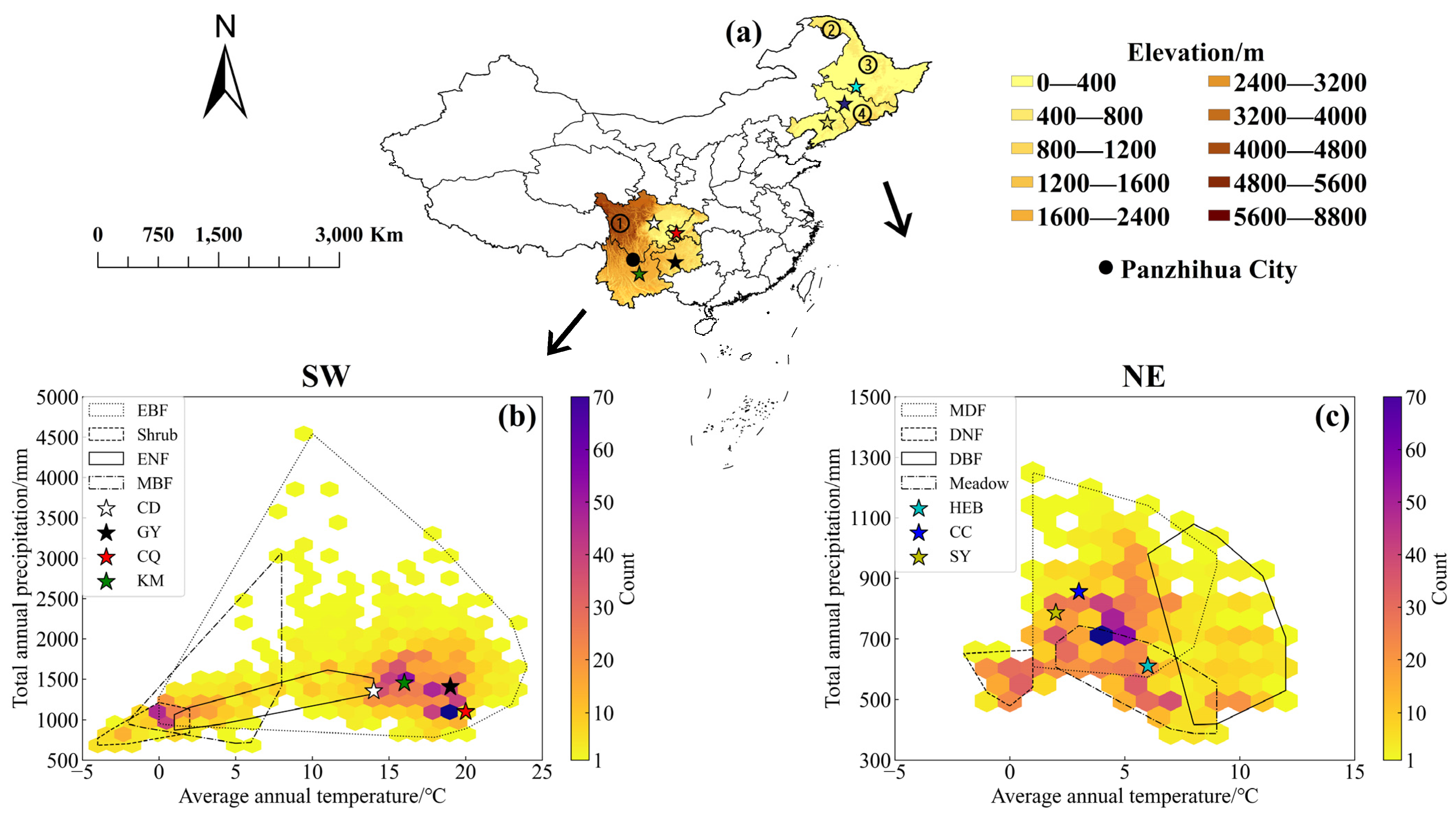
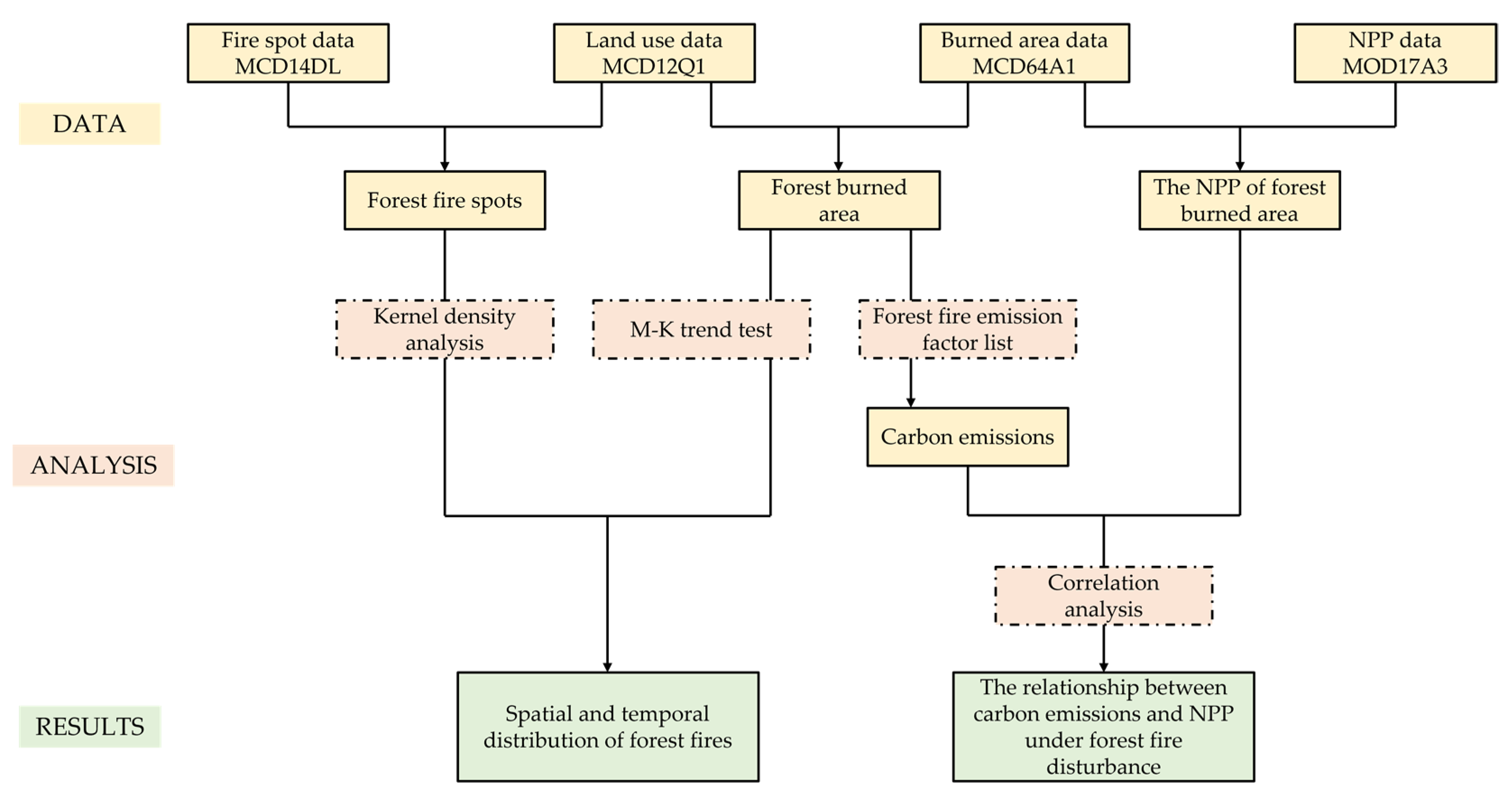

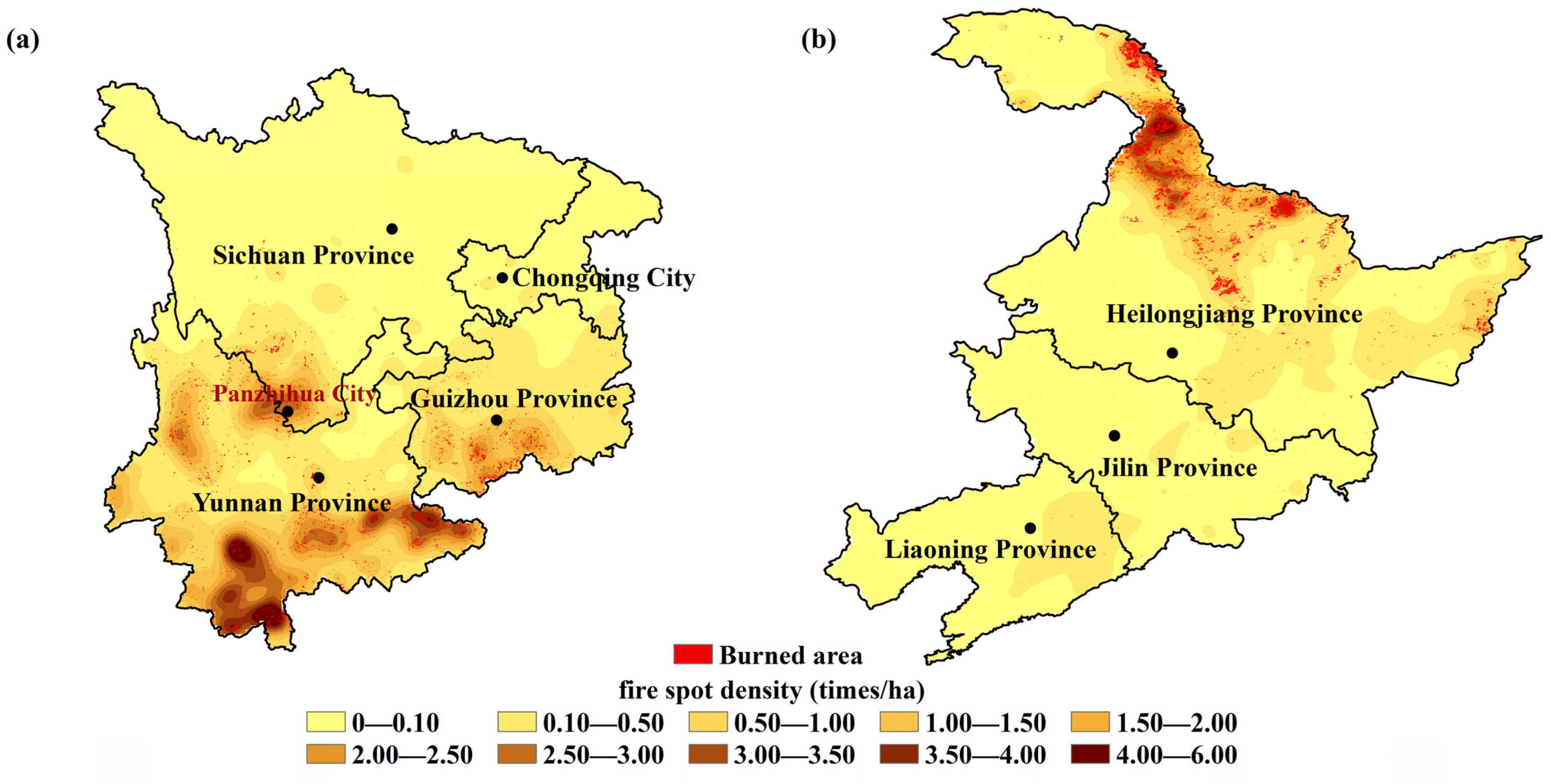

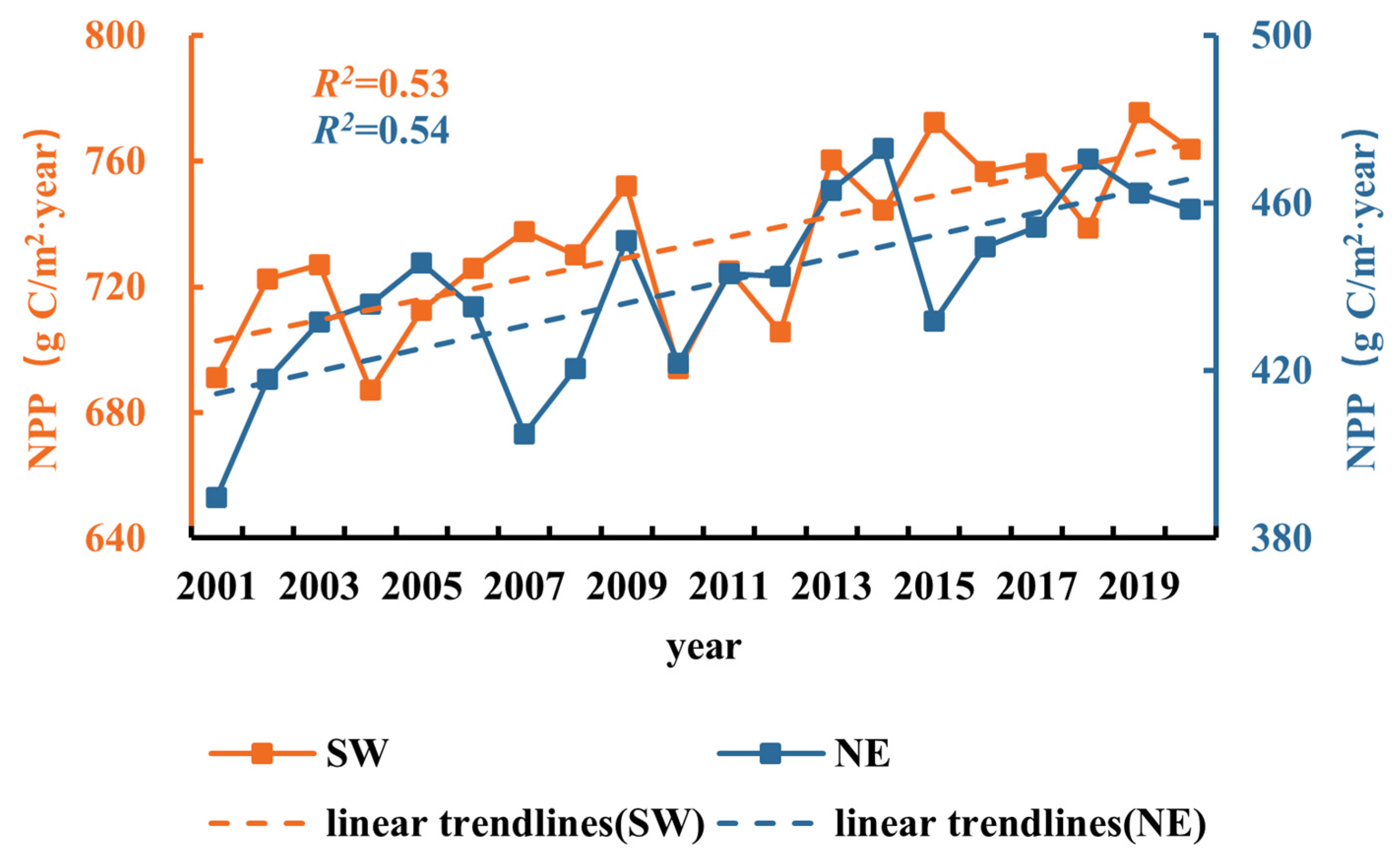

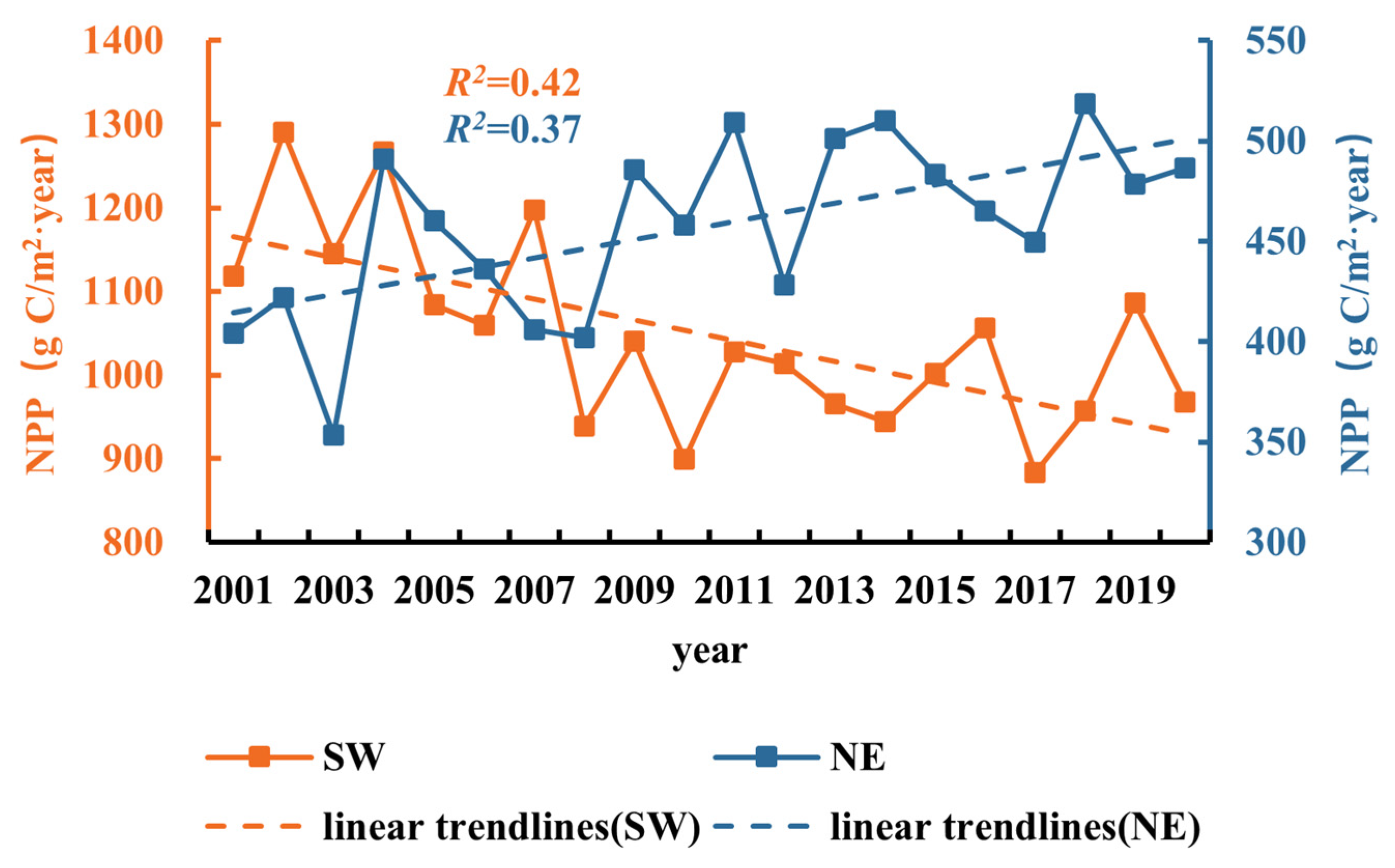

| Forest Type | Biomass Density (Unit: Mg·ha−1) | Forest Burning Efficiency | References |
|---|---|---|---|
| ENF | 365.81 | 25% | [18,33,34] |
| EBF | 248.58 | 25% | [18,34] |
| DNF | 159.13 | 25% | [18,34] |
| DBF | 120.32 | 25% | [18,34] |
| Forest Type | CO2 | CO | CH4 |
|---|---|---|---|
| ENF | 1514 | 118 | 6 |
| EBF | 1643 | 92 | 5.1 |
| DNF | 1514 | 118 | 6 |
| DBF | 1630 | 102 | 5 |
| Year | CO2 | CO | CH4 | C | ||||
|---|---|---|---|---|---|---|---|---|
| SW | NE | SW | NE | SW | NE | SW | NE | |
| 2001 | 2541.08 | 8022.77 | 150.06 | 502.15 | 8.05 | 24.62 | 756.65 | 2400.54 |
| 2002 | 1535.41 | 5040.95 | 88.00 | 316.51 | 4.79 | 15.53 | 455.99 | 1508.80 |
| 2003 | 8150.29 | 32,268.90 | 476.96 | 2126.68 | 25.50 | 105.25 | 2424.80 | 9706.01 |
| 2004 | 6602.91 | 7392.14 | 376.62 | 462.95 | 20.55 | 22.70 | 1960.15 | 2211.97 |
| 2005 | 8184.13 | 3357.43 | 483.44 | 210.30 | 25.82 | 10.31 | 2436.96 | 1004.67 |
| 2006 | 3790.00 | 3643.86 | 228.86 | 234.47 | 12.24 | 11.55 | 1130.89 | 1093.33 |
| 2007 | 6745.35 | 5419.50 | 398.15 | 339.57 | 21.32 | 16.65 | 2008.44 | 1621.77 |
| 2008 | 2795.13 | 6696.91 | 172.92 | 420.44 | 9.17 | 20.62 | 835.91 | 2004.42 |
| 2009 | 6611.59 | 4455.64 | 399.99 | 278.82 | 21.01 | 13.67 | 1972.88 | 1333.17 |
| 2010 | 31,259.06 | 3255.63 | 1859.45 | 212.03 | 98.08 | 10.47 | 9313.07 | 978.05 |
| 2011 | 2150.43 | 2685.81 | 127.57 | 168.19 | 6.88 | 8.25 | 640.63 | 803.67 |
| 2012 | 7576.70 | 771.45 | 455.68 | 49.22 | 24.25 | 2.42 | 2259.84 | 231.27 |
| 2013 | 6504.59 | 2290.35 | 403.22 | 143.58 | 21.37 | 7.04 | 1945.65 | 685.41 |
| 2014 | 7804.50 | 2147.11 | 487.11 | 134.73 | 25.66 | 6.61 | 2335.92 | 642.61 |
| 2015 | 4205.47 | 4093.35 | 251.24 | 259.43 | 13.38 | 12.75 | 1253.54 | 1226.32 |
| 2016 | 4517.83 | 3576.77 | 271.27 | 223.82 | 14.06 | 10.97 | 1347.01 | 1070.20 |
| 2017 | 1428.28 | 3727.32 | 95.47 | 233.43 | 4.91 | 11.44 | 430.37 | 1115.34 |
| 2018 | 2574.81 | 4695.74 | 158.45 | 295.05 | 8.13 | 14.47 | 769.43 | 1405.57 |
| 2019 | 2673.83 | 6291.61 | 162.86 | 393.89 | 8.64 | 19.31 | 798.44 | 1882.59 |
| 2020 | 8242.43 | 3284.93 | 549.49 | 205.65 | 28.84 | 10.08 | 2483.37 | 982.92 |
| total | 125,893.82 | 113,118.17 | 7596.78 | 7210.92 | 402.65 | 354.70 | 37,559.94 | 33,908.63 |
Disclaimer/Publisher’s Note: The statements, opinions and data contained in all publications are solely those of the individual author(s) and contributor(s) and not of MDPI and/or the editor(s). MDPI and/or the editor(s) disclaim responsibility for any injury to people or property resulting from any ideas, methods, instructions or products referred to in the content. |
© 2023 by the authors. Licensee MDPI, Basel, Switzerland. This article is an open access article distributed under the terms and conditions of the Creative Commons Attribution (CC BY) license (https://creativecommons.org/licenses/by/4.0/).
Share and Cite
Zhang, W.; Yang, Y.; Hu, C.; Zhang, L.; Hou, B.; Wang, W.; Li, Q.; Li, Y. NPP and Carbon Emissions under Forest Fire Disturbance in Southwest and Northeast China from 2001 to 2020. Forests 2023, 14, 999. https://doi.org/10.3390/f14050999
Zhang W, Yang Y, Hu C, Zhang L, Hou B, Wang W, Li Q, Li Y. NPP and Carbon Emissions under Forest Fire Disturbance in Southwest and Northeast China from 2001 to 2020. Forests. 2023; 14(5):999. https://doi.org/10.3390/f14050999
Chicago/Turabian StyleZhang, Wenyi, Yanrong Yang, Cheng Hu, Leying Zhang, Bo Hou, Weifeng Wang, Qianqian Li, and Yansong Li. 2023. "NPP and Carbon Emissions under Forest Fire Disturbance in Southwest and Northeast China from 2001 to 2020" Forests 14, no. 5: 999. https://doi.org/10.3390/f14050999
APA StyleZhang, W., Yang, Y., Hu, C., Zhang, L., Hou, B., Wang, W., Li, Q., & Li, Y. (2023). NPP and Carbon Emissions under Forest Fire Disturbance in Southwest and Northeast China from 2001 to 2020. Forests, 14(5), 999. https://doi.org/10.3390/f14050999






